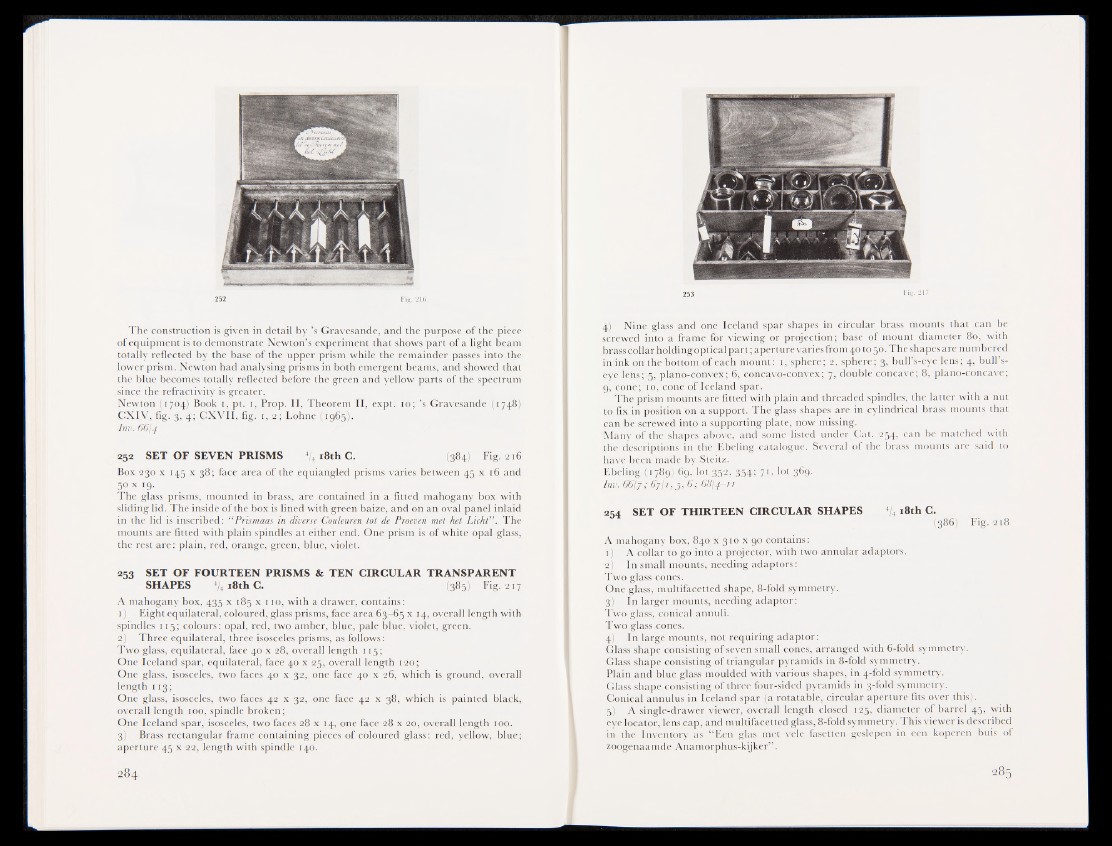
The construction is given in detail b y ’s Gravesande, and the purpose of the piece
of equipment is to demonstrate Newton’s experiment that shows part of a light beam
totally reflected by the base of the upper prism while the remainder passes into the
lower prism. Newton had analysing prisms in both emergent beams, and showed that
the blue becomes totally reflected before the green and yellow parts of the spectrum
since the refractivity is greater.
Newton (1704) Book L pt. 1, Prop. II, Theorem II, expt. 10; ’s Gravesande t|t 748)
CXIV, fig. 3, 4; CXVII, fig. 1,2; Lohne (1965!^^
Inv. 66/4
252 SET OF SEVEN PRISMS % 18th C. 1384) Pig. 216
Box 230 x 145 x 38; face area of the equiangled prisms varies between 45 x 16 and
50 x 19.
The glass prisms, mounted in brass, are contained in a fitted mahogany box with
sliding lid. The inside of the box is lined with green baize, and on an oval panel inlaid
in the lid is inscribed: “ Prismaas in diverse Couleuren tot de Promen met het Licht” . The
mounts are fitted with plain spindles at either end. One prism is of white opal glass,
the rest are: plain, red, orange, green, blue, violet.
253 SET OF FOURTEEN PRISMS & TEN CIRCULAR TRANSPARENT
SHAPES 4/4 18th C. (38|i Fig- 217
A mahogany box, 435 x 185 x 110, with a drawer, contains :
1) Eight equilateral, coloured, glass prisms, face area 63—65 x 14, overall length with
spindles 115; colours: opal, red, two amber, blue, pale blue, violet, green.
2) Three equilateral, three isosceles prisms, as follows:
Two glass, equilateral, face 40 x 28, overall length 115;
One Iceland spar, equilateral, face 40 x 25, overall length 120;
One glass, isosceles, two faces 40 x 32, one face 40 x 26, which is ground, overall
length 113;
One glass, isosceles, two faces 42 x 32, one face 42 x 38, which is painted black,
overall length 100, spindle broken;
One Iceland spar, isosceles, two faces 28 x 14, one face 28 x 20, overall length 100.
3) Brass rectangular frame containing pieces of coloured glass: red, yellow, blue;
aperture 45 x 22, length with spindle 140.
4® Nine glass and one Iceland spar shapes in circular brass mounts that can be
screwed into a frame for viewing or projection; base of mount diameter 80, with
brass collar holding optical part; aperture varies from 40 to 50. The shapes are numbered
in ink on the bottom of each mount: I, sphere ^»sphere; 3, bull’s-eye lens; 4, bull’s-
eye lens; 5, plano-convex; 6, concavo-convex; 7, double concave; 8, plano-concave;
9, cone ; 10, cone of Iceland spar.
The prism mounts are fitted with plain and threaded spindles, the latter with a nut
to fix in position on a support. The glass shapes are in cylindrical brass mounts that
can be screwed into a supporting plate, now missing.
Many of the shapes above, and some listed under Oat. 254, can be matched with
the descriptions in the Ebelitig catalogue. Several of the brass mounts are said to
Mave beeti made by Steitz.
Ebelin^SySg) 69, lot 352, 354; 71, lot 369.
Inv. 6'6;7 ; 67j 1 , 5 , 6,' Oil 14 11
254 SET OF THIRTEEN CIRCULAR SHAPES 4/4 18th C.
(386) Fig. 218
A mahogany box, 840 x 310 x 90 contains:
i l l A collar to go into a projector, with two annular adaptors.
2^ In small mounts, needing adaptors:
Two glass cones.
One glass, multifacetted shape, 8-fold symmetry.
3) In larger mounts, needing adaptor:
Two glass, conical annuli.
Two glass cones.
4) In large mounts, not requiring adaptor:
Glass shape consisting of seven small cones, arranged with 6-fold symmetry.
Glass shape consisting of triangular pyramids in 8-fold symmetry.
Plain and blue glass moulded with various shapes, in 4-fold symmetry.
Glass shape consisting of three four-sided pyramids in 3-fold symmetry.
Conical annulus in Iceland spar (a rotatable, circular aperture fits over this).
5) A single-drawer viewer, overall length closed 125, diameter of barrel 45, with
eye locator, lens cap, and multifacetted glass, 8-fold symmetry. This viewer is described
in the Inventory as “ Een glas met vele fasetten geslepen in een koperen buis of
zoogenaamde Anamorphus-kijker” .